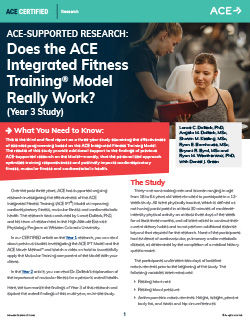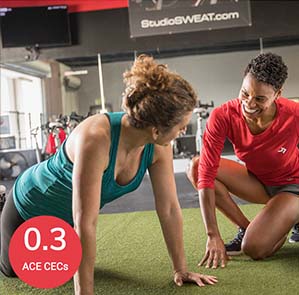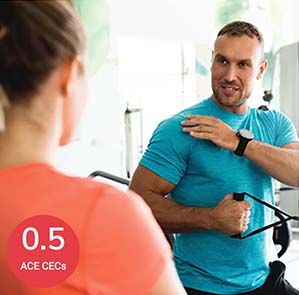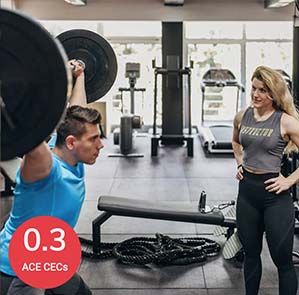ACE-SUPPORTED RESEARCH: Does the ACE Integrated Fitness Training® Model Really Work? (Year 3 Study)

What You Need to Know
This is the third and final report on a three-year study examining the effectiveness of exercise programming based on the ACE Integrated Fitness Training Model. The results of this study provide additional support to the findings of previous ACE-supported research on the Model—namely, that the personalized approach optimizes training responsiveness and positively impacts cardiorespiratory fitness, muscular fitness and cardiometabolic health.
Over the past three years, ACE has supported ongoing research investigating the effectiveness of the ACE Integrated Fitness Training (ACE IFT®) Model at improving cardiorespiratory fitness, muscular fitness and cardiometabolic health. The research was conducted by Lance Dalleck, PhD, and his team of researchers in the High Altitude Exercise Physiology Program at Western Colorado University.
In our CERTIFIED article on the Year 1 research, you can read about previous studies investigating the ACE IFT Model and the ACE Mover Method™ and watch a video on how to successfully apply the Muscular Training component of the Model with your clients.
In the Year 2 article, you can read Dr. Dalleck’s explanation of the importance of muscular fitness for a person’s overall health.
Here, we summarize the findings of Year 3 of this research and explore the overall findings of this multi-year, multi-site study.
The Study
Thirty-one nonsmoking men and women ranging in age from 18 to 64 years old were recruited to participate in a 13-week study. All were physically inactive, which is defined as not having participated in at least 30 minutes of moderate-intensity physical activity on at least three days of the week for at least three months, and all were asked to continue their current dietary habits and to not perform additional exercise beyond that required for the research. None of the participants had evidence of cardiovascular, pulmonary and/or metabolic disease, as determined by the completion of a medical history questionnaire.
The participants underwent two days of baseline measurements prior to the beginning of the study. The following variables were measured:
- Resting heart rate
- Resting blood pressure
- Anthropometric measurements: Height, weight, percent body fat, and waist and hip circumferences
- Fasting blood lipids
- Fasting blood glucose
- Assessments for muscular strength: Five-repetition maximum (5-RM) for the bench press and leg press exercises
- Maximal exercise testing: Maximal oxygen consumption (VO2max) and maximal heart rate [note that heart-rate reserve (HRR) was calculated for each participant by subtracting resting heart rate from maximal heart rate]
- First and second ventilatory thresholds (VT1 and VT2)
After completing the baseline assessments, the participants were randomized into three groups:
- ACE IFT Model group
- Standardized Training group
- Control group
Cardiorespiratory Training
The cardiorespiratory exercise was performed on various modalities: arm, cycle and rowing ergometers; elliptical crosstrainers; and treadmills. The Standardized Training group worked at an intensity based on a percentage of their HRR, while those in the ACE IFT Model group received programming based on their ventilatory thresholds. For both groups, a target heart rate was determined to coincide with either the HRR or ventilatory thresholds to establish a specific intensity for each exercise session.
The cardiorespiratory training programs progressed for both groups over the course of the 13 weeks. Frequency remained consistent for both exercise groups, at three workouts per week throughout the study.
For the Standardized Training group, cardiorespiratory exercise began in week 1 at 40 to 45% of HRR for 25 minutes per day. The duration of each training session was extended by 5 minutes each week until weeks 5 and 6, when intensity increased to 50 to 55% HRR for 45 minutes per day. Then, in weeks 7 and 8, duration increased to 50 minutes per day. For the final five weeks of the study, this group exercised at 60 to 65% HRR for 50 minutes per day.
For the ACE IFT Model group, cardiorespiratory exercise began at a heart rate below VT1 for 25 minutes per day. As with the standardized training group, the duration of training sessions was extended by 5 minutes per week until weeks 5 and 6, when intensity increased to a heart rate equal to or greater than VT1 but below VT2. Then, in weeks 7 and 8, duration increased to 50 minutes per day. For the final five weeks of the study, this group exercised at an intensity equal to or greater than VT2 for 50 minutes per day.
Muscular Training
Muscular training was introduced during week 4 and continued to be performed three days per week through week 13.
For the Standardized Training group, the program consisted of the following single- and multijoint exercises performed on machines:
- Bench press
- Shoulder press
- Lat pull-down
- Seated row
- Biceps curl
- Triceps push-down
- Seated leg press
- Seated leg extension
- Prone leg curl
- Seated back extension/flexion
Two sets of 12 repetitions were completed for each exercise. Resistance was progressed every two weeks by approximately 3 to 5% of the total weight lifted for the upper body and approximately 6 to 10% for lower-body exercises. A session rating of perceived exertion (RPE) of 5 to 6 on the 0-to-10 scale was maintained across the training program.
For the ACE IFT Model group, muscular training consisted of multijoint/multiplanar exercises using both free weights and machines. The machines allowed for free motion during the exercises, meaning that range of motion was not limited to a specific arc. The following exercises were performed:
- Stability ball circuit (glute bridges, crunches, Russian twists, planks)
- Lunge matrix
- Kneeling/standing wood chops
- Kneeling/standing hay balers
- Dumbbell squat to 90-degree knee bend
- Standing one-arm cable row
- Step-ups with dumbbell onto a 6-inch (15-cm) step
- Modified (assisted) pull-ups
- Dumbbell bench press
Two sets of 12 repetitions were completed for each exercise. The intensity of weighted exercises started at 50% of 5-RM and was progressed by 5% of 5-RM increments every two weeks. For exercises that did not include a weighted resistance (e.g., stability ball circuit), the number of repetitions was increased by approximately 5 to 10% to maintain an RPE rating of 5 to 6 on the 0-to-10 scale.
Figure 1 provides a flow chart of the experimental procedures and exercise programs for all three groups.
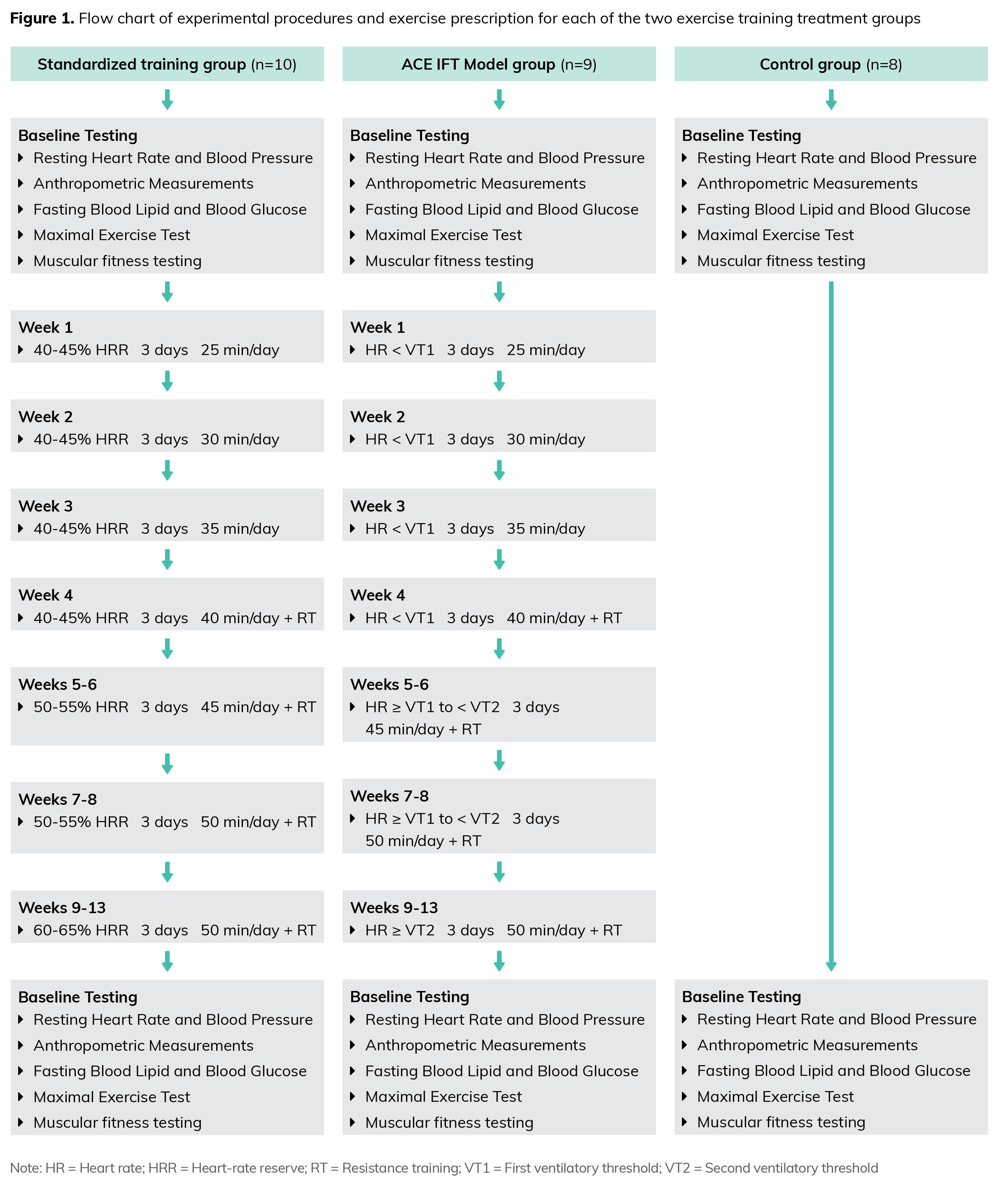
The Results
Note: The data and analysis presented here are for the Year 3 participants only.
Adherence to the exercise program was excellent for both the Standardized Training group (92.7%) and the ACE IFT Model group (91.5%). The physical and physiological characteristics for the participants are presented in Table 1. Importantly, the three groups did not differ in physical or physiological characteristics prior to the study.
Here are the key findings, as presented in Table 1:
After 13 weeks, changes in the following values were statistically more desirable in the Standardized Training group compared to the Control group: body mass, waist circumference, body-fat percentage, VO2max, bench press 5-RM and leg press 5-RM.
Meanwhile, changes in those same values were statistically more desirable in the ACE IFT Model group when compared to both the Standardized Training group and the Control group.
Finally, the ACE IFT Model group saw a statistically significant improvement in systolic blood pressure, high-density lipoprotein (HDL) cholesterol and blood glucose relative to the Control group.
Stated more simply, while the Standardized Training protocol yielded significant changes compared to the Control group, the ACE IFT Model program drove even more dramatic improvements across multiple measures of cardiorespiratory fitness, muscular fitness and cardiometabolic health.
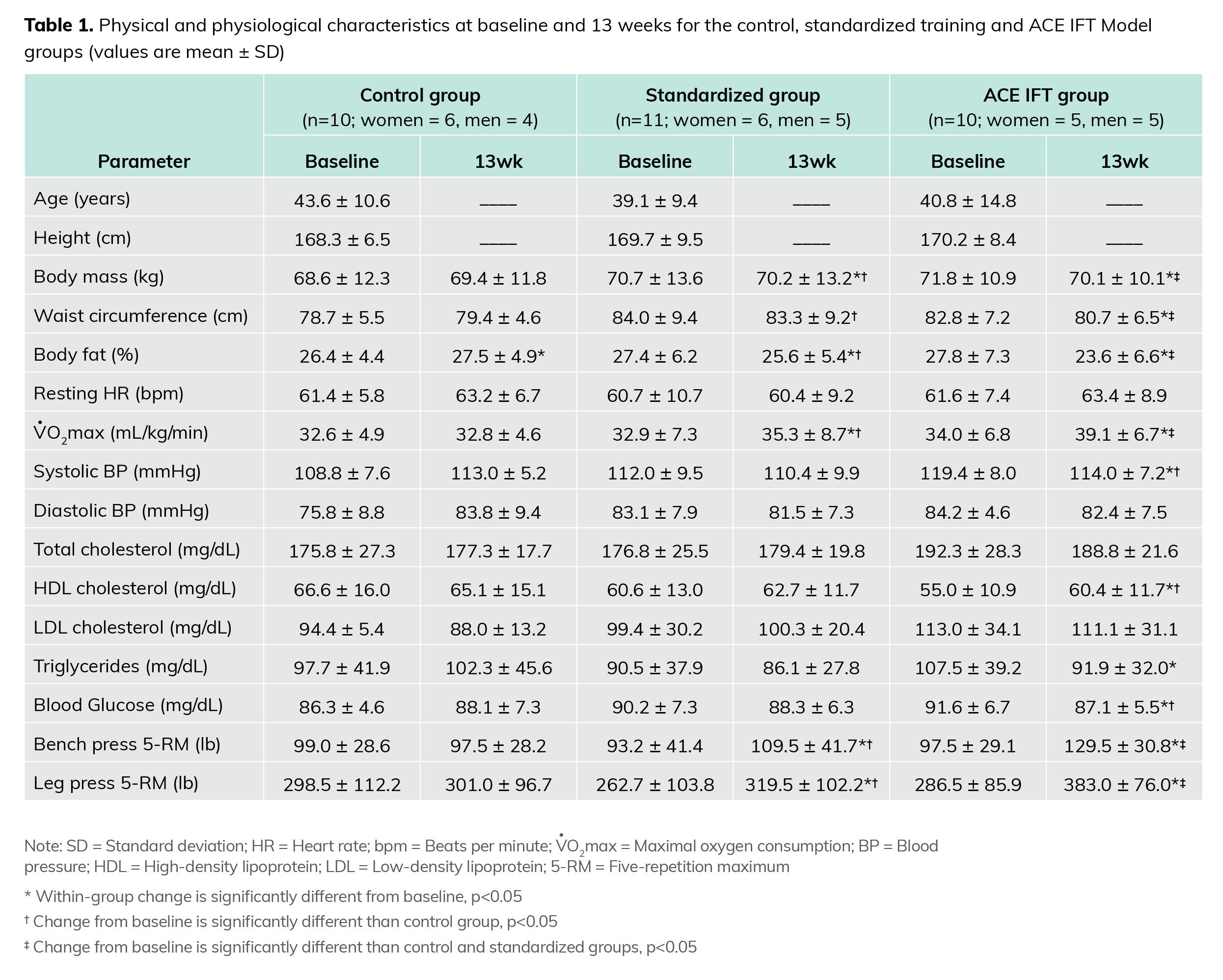
Another area where Dr. Dalleck and his team have focused their analysis is the prevalence of responders vs. non-responders in each training group. Figure 2 shows the number of responders and non-responders in the Standardized Training group and ACE IFT Model group in terms of improvements in their VO2max, which is a standard measure of cardiorespiratory fitness. As you can see, five of the 11 members of the Standardized Training group were non-responders, meaning that they did not experience a statistically favorable change in their VO2max over the course of the 13-week study. In contrast, the ACE IFT Model group had only one non-responder among 10 participants.
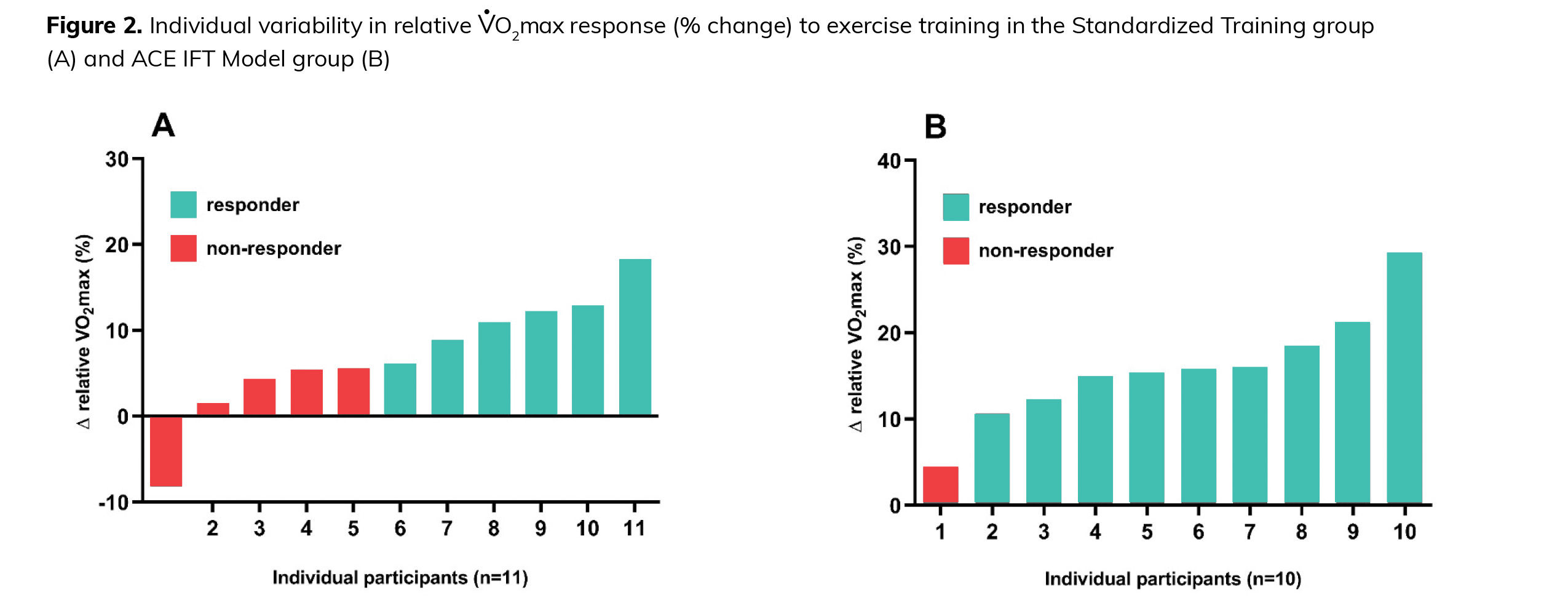
Figure 3 presents the prevalence of non-responders in the two measures of muscular fitness used in this study: 5-RM in the bench press and leg press exercises. While training responsiveness was similar between the two groups, two important pieces of data emerged: (1) there was less variability in the changes seen in the ACE IFT Model group, which demonstrates that the personalized nature of this programming provides a more uniform and beneficial training response, and (2) the magnitude of change in the ACE IFT Model group was approximately 1.5 to 2 times greater than in the Standardized Training group.
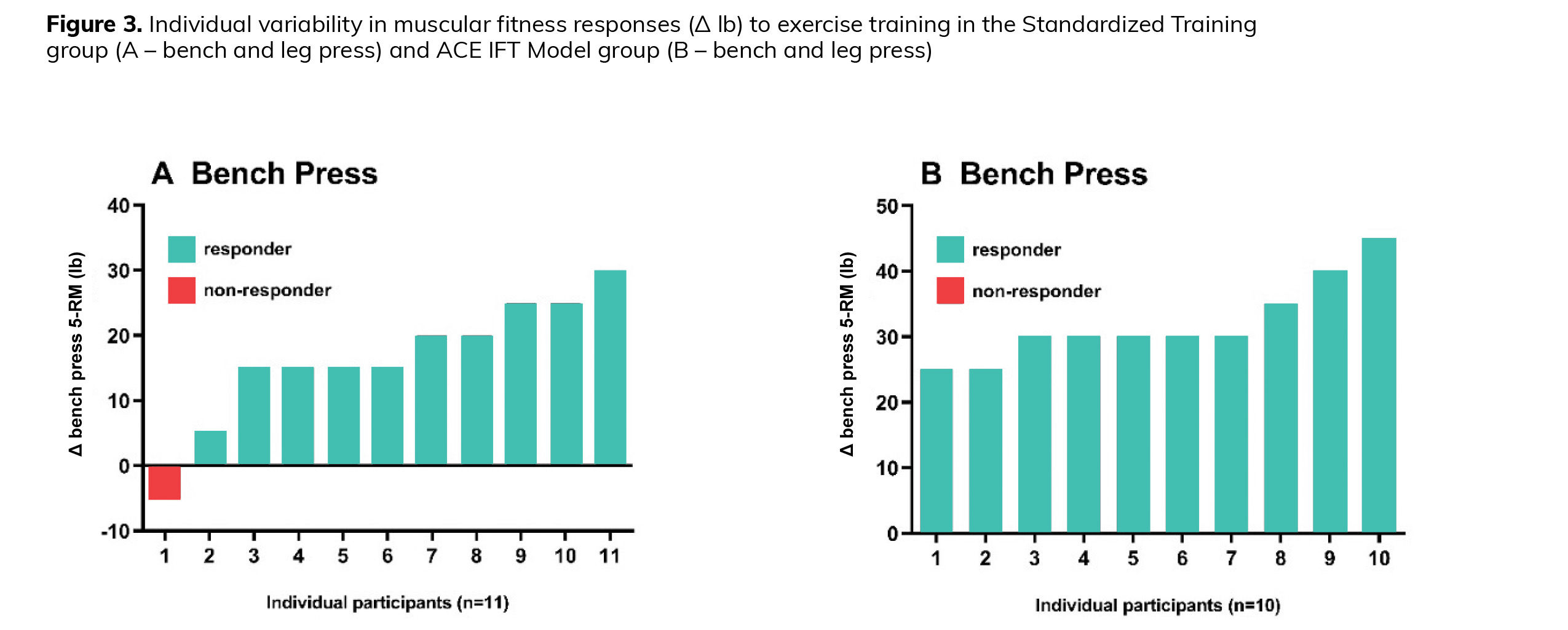

The Bottom Line
Perhaps the most meaningful outcome of these findings is their consistency with those from Years 1 and 2 of this multi-year study. This research further supports the implementation of personalized exercise programming like that featured in the ACE IFT Model as a tool to drive more consistent and dramatic improvements in your clients’ cardiorespiratory fitness, muscular fitness and cardiometabolic health.
When reading through research on a particular topic, it is common to find results that are inconsistent or even contradictory. That’s why it is so important to avoid overselling the findings of a single piece of research, as the participants are simply a subsample of the larger population.
“The fact that we have comparable findings, over three years with three different cohorts, shows that the Year 1 results weren’t just a fluke,” explains Dr. Dalleck. “It adds more and more credibility to the idea that the personalized approach that the ACE IFT Model provides does what it’s intended to do. It matches the individual’s physiology and goals to the programming and, as a result, we have consistent improvements in key health outcomes.”
Finally, as Dr. Dalleck explains, “Not only are cardiorespiratory and muscular fitness improving more consistently and to a greater magnitude in the ACE IFT Model group, but cardiometabolic health is as well. That encompasses waist circumference, triglycerides, HDL cholesterol, blood pressure and blood glucose, and so, the more we can emphasize the entire array of health benefits to be accrued from exercise and, in particular, how those benefits may change with personalized exercise programming, the better.”
Expand Your Knowledge
Exercise Programming Toolkit – Course Bundle
The ACE Integrated Fitness Training® Model Exercise Programming Toolkit course bundle explores the different components of the ACE IFT® Model, including the ACE Mover MethodTM, to help you develop safe and effective exercise plans. By gaining an understanding of how to move through the phases of the ACE IFT Model, you will be able to effectively educate clients and gain their trust, keeping them safe as they move toward their goals.
Essential Toolkit for Exercise Professionals – Course Bundle
The Essential Toolkit for Exercise Professionals course bundle, you will discover key skills to help your clients achieve their fitness goals. From behavior-change strategies, nutrition coaching, strength training and more, you will build the foundation for success as an exercise professional.
Strategies for Enhancing Program Design – Course Bundle
When designing an exercise program for clients, there are many ways to create safe and effective training plans. The Strategies for Enhancing Program Design – Course Bundle will elevate your exercise programs by showing you how to integrate agility training, HIIT and the ACE Integrated Fitness (ACE IFT) Model.
More Articles
- Certified™: June 2023
Say Hello to Your New Personal Assistant: How AI Can Save You Time and Help Build Your Business
Contributor
- Certified™: June 2023
Talkin’ ‘Bout Their Generations: The X, Y and Z’s of Attracting and Training Clients From Different Age Groups
Contributor
- Certified™: June 2023





